
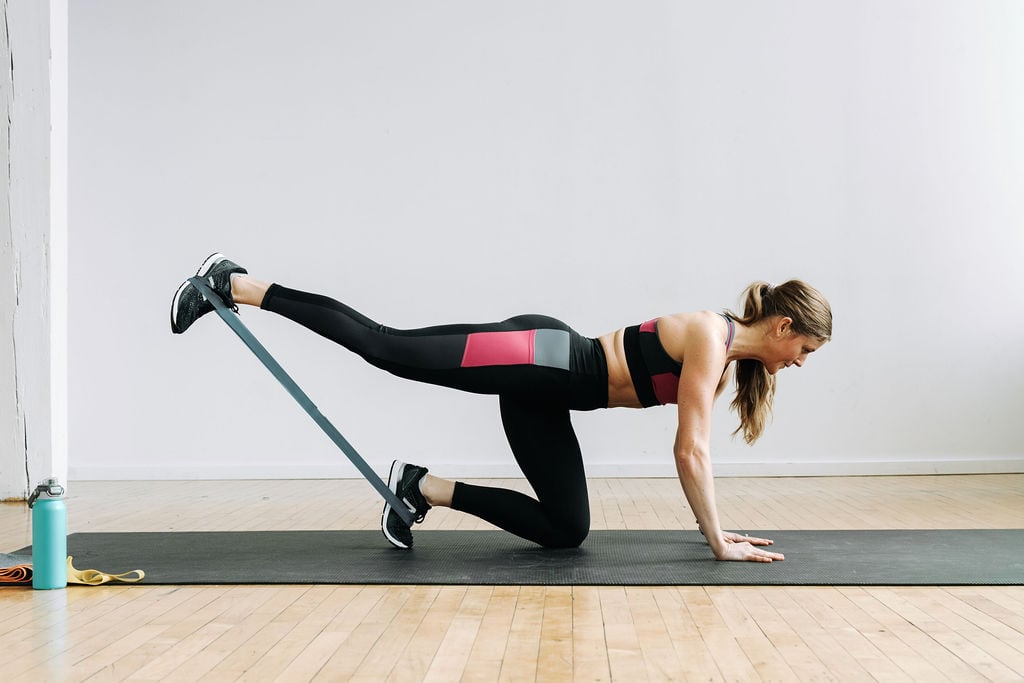
8 Resistance Band Exercises for Legs
Legs, glutes, quads, hamstrings and thighs — in 30 minutes you will fatigue every muscle group in your lower body using a mini loop resistance band. These banded exercises will build strong legs and strengthen knee joints; making this leg workout a great addition to any home workout plan.
I will always advocate for women to pick up weights and strength train. But I also believe a well-rounded fitness routine includes VARIETY — using different equipment, training in all planes of motion and challenging your muscles in new ways.
Resistance band workouts are one of the best ways to work BOTH the large and small muscles in the lower body.
Mini loop resistance bands are a great piece of home gym equipment to activate your glutes and strengthen your hips through various lower body exercises.

Resistance Band Exercises for Legs FAQs
Resistance band exercises target and activate the glutes and hamstrings. Resistance band leg workouts target smaller, stabilizing muscles that can be overpowered by larger muscle groups (which is also great for strengthening knees and injury prevention).
Yes! Weight training typically targets the larger lower body muscles, leaving out the smaller, stabilizing muscles in the lower body. Resistance band leg workouts are one of the best ways to work BOTH the large and small muscles in the lower body.
If you want to make a workout more challenging, add a resistance band. A resistance band increases the time under tension — or the amount of time a muscle is working. Resistance bands are also great at working both larger muscle groups and smaller, stabilizing muscles (like the core and pelvic floor) that are harder to target with free weights.
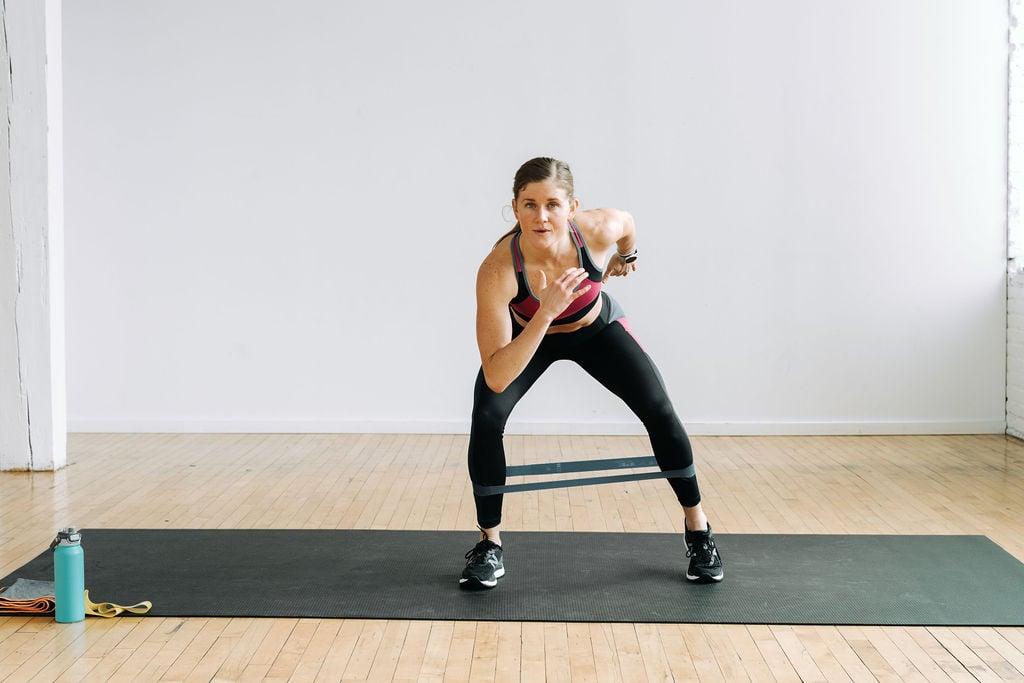
30-Minute Resistance Band Leg Workout
Strengthen all of the major muscle groups in the lower body; no fancy gym equipment needed. If you travel regularly or enjoy working out at home, this resistance band leg workout is for you.
These 8 leg exercises with bands are a great compliment to any strength training plan, designed to:
- Activate glute muscles
- Strengthen weak knees and hips (especially important for runners)
- Engage stabilizing muscles and core muscles
Workout Equipment:
Mini Loop Resistance Band (discount code: NML). I’m using a light-to-medium resistance band in this band workout.
Shop My Resistance Bands
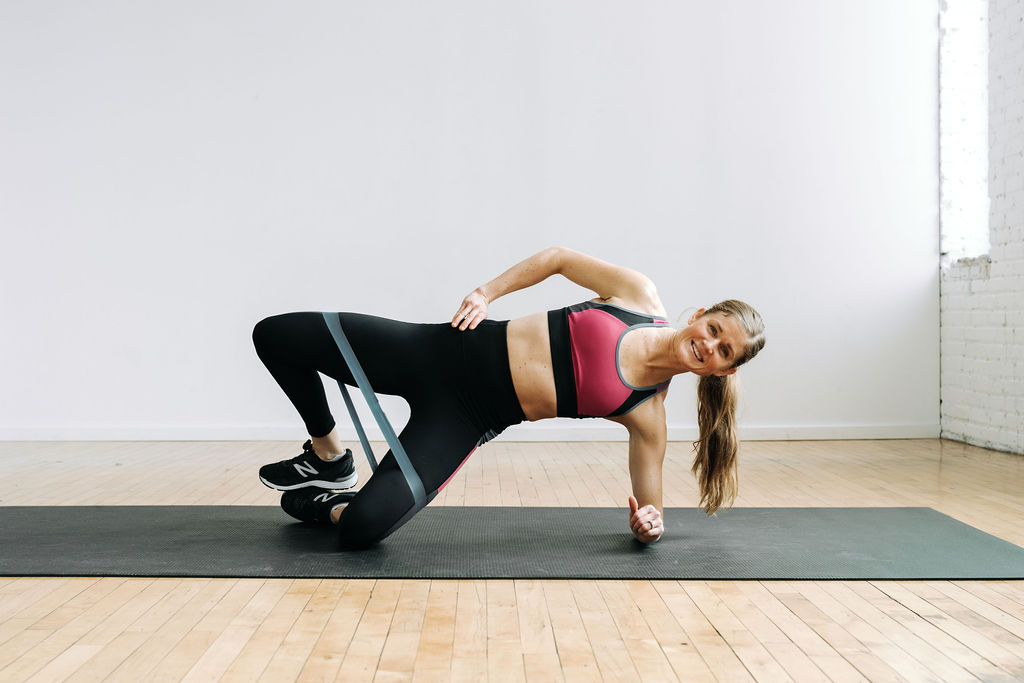
Workout Instructions:
Follow along with the guided Resistance Band Leg Workout on YouTube, led by certified personal trainer, Lindsey Bomgren.
Your Workout Looks Like This:
- 8 Circuits
- 2 Moves Per Circuit (Strength Exercise and Burnout Exercise)
- Timed Intervals (40 seconds of strength training, followed by a 20 second strength burnout, followed by 20 seconds of rest between circuits)
- Repeat Each Circuit x2 Sets
Workout Outline
CIRCUIT ONE
- Squat and Abduction
- Single Leg Runners (Right/Left)
CIRCUIT TWO
- Lateral Squat Walk
- Bear Crawl Hold and Abduction
CIRCUIT THREE
- 3-Way Squat (Right/Left)
- V-Walks
CIRCUIT FOUR
- Staggered Squat and Rear Leg Lift (Right/Left)
- 3 Fast Feet Runners and Squat Drop
CIRCUIT FIVE
- Hip Hinge and Lunge (Right/Left)
- Single Leg Squat (Right/Left)
CIRCUIT SIX
- Clamshell and Kick (Right/Left)
- Superman Band Opens
CIRCUIT SEVEN
- Glute Bridge and Band Abduction
- Glute Bridge Pulses
CIRCUIT EIGHT
- Table Top Single Leg Kick Back and Lift (Right/Left)
- Bear Crawl Kick Backs

Prefer to Watch On YouTube?
8 Best Resistance Band Exercises for Stronger Legs
Squat and Abduction
Targets: Quads, glutes, hamstrings, hip abductors and core.

How To Do A Squat and Abduction
- Place the band about six inches above your knees and stand with your feet shoulder-width distance apart.
- Lower your body into a squat position by bending your knees and pushing your hips back.
- As you reach the bottom of the squat hold, push your knees outward to activate your glutes and abductors.
- Hold this position for a few seconds, then push back through your heels to return to the starting position.
Lateral Squat Walk
Targets: Glutes, quads, hamstrings and hip abductors.
A GREAT exercise to build strong and healthy hips and knees.

How To Do A Lateral Squat Walk
- Place the band about six inches above your knees. Stand with your feet slightly wider than your hips to create tension across the band (activating your glutes).
- Bend your knees to lower down into a loaded squat position. Weight in heels, chest up.
- Hold this loaded squat position as you take two lateral steps to your right; stretching the band as far as you can.
- Tap your left foot in, bringing it towards your right foot, maintaining a low squat position.
- Then, step out with your left leg, maintaining tension across the band before bringing your right leg to the left to meet your outside foot.
3-Way Squat
Targets: Glutes, quads, hamstrings and core.

How To Do A 3-Way Squat
- Place the band six inches above your ankle joints (around your calves/shins).
- Standing on your right leg, step the left foot slightly in front of you and lower your body into a squat position by bending your knees and pushing your hips back.
- Push up through your heels to return to the starting position.
- Step the left leg slightly to the side, parallel with the right leg and lower your body into a squat position by bending your knees and pushing your hips back.
- Push up through your heels to return to the starting position.
- Step the left leg slightly behind you and lower your body into a squat position by bending your knees and pushing your hips back.
- Push up through your heels to return to the starting position.
Staggered Squat and Rear Leg Lift
Targets: Glutes, quads, hamstrings and hip abductor muscles.
A great exercise to target the stabilizing muscles around the knee, as well as strengthening glutes which are essential to everyday movements.

How To Do A Staggered Squat And Rear Leg Lift
- Place the band six inches above your ankle joints (around your calves/shins).
- Start in an athletic stance or loaded squat position, with your feet hip-width apart and slightly staggered. Left foot slightly in front of right foot; 80% of your weight in your left heel, and 20% of your weight in your back right toe.
- With your chest upright and your core engaged, squat until your left knee reaches a 90-degree angle. Driving your knee outward against the band as you squat.
- Drive through your front left heel to return to standing as you squeeze your right glute to extend your right leg behind you.
Hip Hinge And Lunge
Targets: Legs, quads, glutes, hip extensions, hamstrings and lower back muscles.

How To Do A Hip Hinge And Lunge
- Stand with your feet hip-width apart and place the resistance band under the sole of your front foot. Hold the other end of the band with the same hand as your front foot.
- Hinge forward from your hips, keeping your back straight and your core engaged. The resistance band should provide tension as you hinge forward.
- As you hinge forward, simultaneously lift your back leg off the ground, extending it straight behind you.
- Once you’ve reached a comfortable range of motion, reverse the movement and bend your front knee to lower into a lunge. Keeping your back straight and your core engaged.
- Push back up through your front foot to return to the starting position, holding the resistance band in the same hand.
Clamshell And Kick
Targets: Gluteus medius (which lays on the outer edge of the glute and is responsible for stabilizing your pelvis), gluteus minimus (hip extensions), obliques and core.
Clamshell exercises can help balance the muscular effort between your inner and outer thighs and your pelvic floor. A great exercise for pregnancy and postpartum.

How To Do A Clamshell And Kick
- Place the band about six inches above your knees.
- Lie on one side, with legs stacked and knees bent at a 45-degree angle, soles of the feet to touch.
- Rest on the forearm of the lower arm, shoulder stacked over elbow.
- Exhale to engage the core and stabilize your spine and pelvic floor.
- Keeping your feet touching, use your outer glutes and hips to lift your resting hip off the floor. As you lift your hips off the ground, open your legs, raising your upper knee as high as you can without shifting your hips or pelvis.
- At the top of the open clamshell, kick your top leg straight out. Pause and hold at the top of the movement for a moment. Then return to the starting position.
Banded Glute Bridge And Band Open
Targets: Glutes, hamstring and hip abductor muscles.
If you have a knee injury or knee pain while squatting or lunging, glute bridges are a great exercise to substitute for squats and lunges.
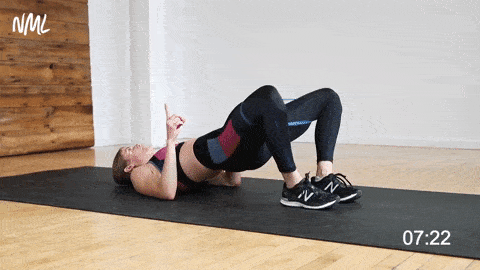
How To Do A Glute Bridge And Resistance Band Open
- Place the band about six inches above your knees and lie on your back, arms straight at your sides, feet flat on the floor, hip-width apart. Feet should be about six inches in front of your glutes. The farther your feet are from your glutes the more you work the hamstrings (and we want to target glute activation here, so keep your feet close to your butt).
- Engage your core and tuck your pelvis toward the ceiling. Then squeeze your glutes as you drive through your heels to lift your hips off the floor.
- Hold at the top of the glute bridge for a moment and drive your knees out towards your pinky toes to activate your outer glutes (abductors), opening the band (knees wider than hips).
- With control return your knees back in alignment with your hips.
- Then lower your hips with control back down to a hover position and repeat this movement.
- Keep constant tension on the band throughout this movement.
Table Top Single Leg Kick Back And Lift
Targets: Glutes, hamstring and hip abductor muscles.

How To Do A Table Top Single Leg Kick Back And Lift
- Place the band around your feet. Start in a quadruped (table top) position on your forearms and knees with your elbows in line with your shoulders and your knees hip-width apart.
- Lift your right leg up, keeping it straight and your foot flexed. Engage your glutes and extend your leg back until it’s parallel to the ground.
- Pause for a moment, then lift your right leg up towards the ceiling while keeping your leg straight.
- As you lower your leg, drive your knee back to table top position, keeping your knee hovering off the mat and push your leg straight out.
- Keep your hips parallel to the floor (try not to move the hips when doing the exercise) and upper body stable, while squeezing the glutes of the straight right leg.
More Workouts
Resistance Band WorkoutsPin this Resistance Band Leg Workout: Best Leg Exercises with Bands











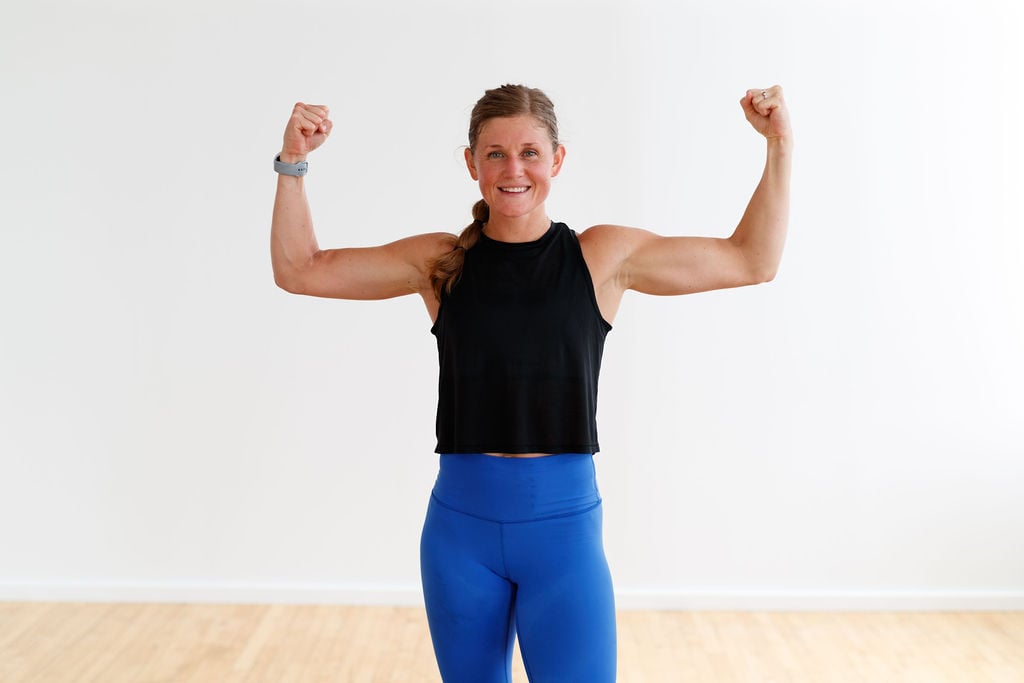




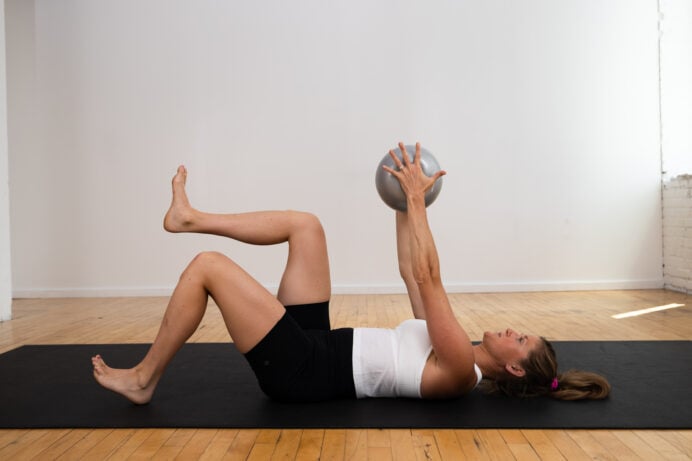
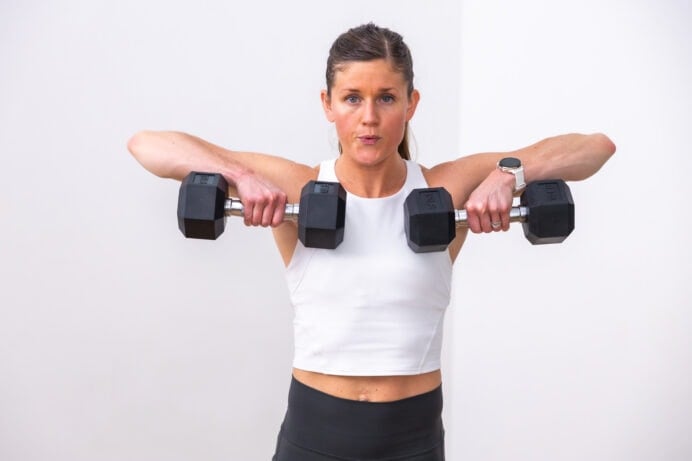







Is this workout pregnancy safe?
Hi Casey! Yes, for the most part this workout is pregnancy safe but you’ll need to modify Circuit 6, move 2 — Superman Band Opens. You can substitute bear crawl for this exercise. As for the rest of the workout it all depends at where you’re at in your pregnancy but you can certainly slow down the moves and reduce the range of motion as needed. Keep up the great work! -Lindsey
Any advice for Pelvic Floor Disorder regarding these workouts. I find new exercise intimidating.
Hi, Shana! I personally started with core recovery before getting into additional workouts (and then targeting low impact strength training). If you search “diastasis recti” on our site, you’ll find several core recovery options that may help. I also highly recommend seeing a pelvic floor physical therapist if that is an option for you! -Lindsey
I love your workouts! I always laugh when you talk about postpartum mamas… I am 334 months postpartum, even after that many years I have gotten so much stronger from your workouts. Thank you!
Janine! I’m so glad you are enjoying the workouts! And I’m sure you can relate to all those PP comments! Keep up the great work! -Lindsey
thank you so much for this. My insurance cut my PT and I still have so much more to go and you’ve included everything and more that my PT was doing with me. Im not able to use resistant bands just yet but im excited to have a challenge to work towards.
So glad you liked this one Carly! I’m sorry about your insurance + PT, but glad you’re seeking alternating solutions and still putting in the work! Keep up the great work! -Lindsey
This was an awesome combination of moves with a resistance band! I loved every minute of it and have repeated it 4 other times!
Shannon! So glad you enjoyed this resistance band workout! Keep up the good work and keep coming back for more! -Lindsey
Great workout and tips! And those tights! 😍 Where are they from?
So glad you liked this resistance band leg workout Brittany! Way to get it done. And yes, the leggings are an older pair of Adidas leggings (from like 2 years ago)….
Loved this 30 min. Resistance band workout. Love all your workouts. It really helps me to get every su day the plan for the week.
Thanks!!
Ana so glad you loved this resistance band leg workout! Thanks for giving it a try and keep up the great work! -Lindsey
Great tips with awesome product reviews. Thank you so much for your kind information.
So glad you find this resistance band workout helpful!